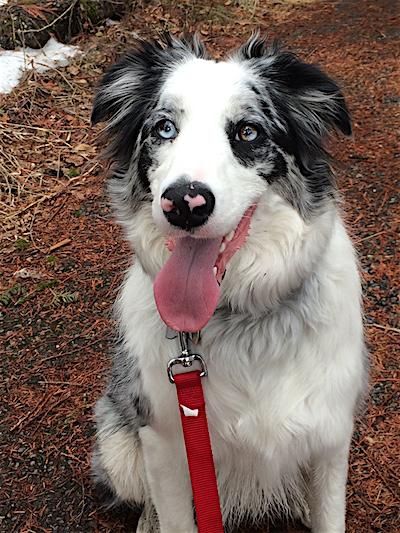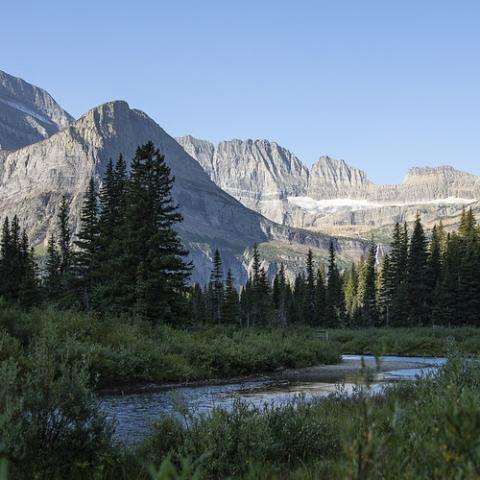
This 2-year-old Border collie will be used to herd wildlife away from visitor areas at Logan Pass this summer/NPS
Editor's note: The second paragraph has been recast to larify that the dog will only be used at the Logan Pass parking lot, not along the boardwalk trail.
In a novel idea that possibly could be used elsewhere in the National Park System if successful, Glacier National Park officials are turning to a dog to keep wildlife a safe distance away from visitors on Logan Pass.
This summer Glacier officials hope the 2-year-old Border collie will safely move mountain goats and bighorn sheep away from the parking area at the Logan Pass Visitor.
Six years ago a mountain goat in Olympic National Park fatally gored a man trying to protect other hikers. The goat, weighing more than 300 pounds, gored Bob Boardman, 63, of Port Angeles, Washington, in the thigh and stood over him while he bled to death. At the time, Glacier officials said that they would closely monitor their own wildlife and its interactions with visitors on Logan Pass, but had no plans to change their regulations or management plans.
“We have a variety of wild animals, most notably grizzly bears and black bears, and yes, we do have goats, sheep, and other animals that are in close proximity to heavy visitor use. I think that we have a pretty good plan and a pretty good program for managing that, but that’s something that I think will always be in the back of our minds," then-Superintendent Chas Cartwright told the Traveler at the time.
"Are we doing the job that we need to do to protect those animals but also protect people? We had a pretty incredible history of not having many people get hurt, much less killed, which is really good, but we need to keep working at that."
Now park officials say that an "increase in park visitation has led to an increase in human–wildlife interactions at Logan Pass in recent years. Visitor interactions with mountain goats and bighorn sheep can be dangerous for both people and wildlife. While no serious injuries have been reported at Logan Pass, habituated wildlife have caused serious injury and even death to visitors in other national parks and wild areas. Wildlife habituation can also lead to the death of the animal."
Glacier staff have used conventional hazing methods (arm-waving, shouting, use of sirens, shaking cans of rocks, and moving vehicles) to move goats and sheep out of the parking lot at Logan Pass, but within a short period of time they usually return. But by using a dog, a predator, to haze the wildlife Glacier officials hope to have more success in moving the mountain goats and bighorn sheep away from the parking lot for longer periods.
“This program represents a proactive method of wildlife management. The park is trying to provide for safe wildlife viewing by moving wildlife a safe distance from a known area of high visitor use,” said Mark Biel, the dog’s owner and Glacier National Park’s Natural Resources Program Manager. “Through the use of a wildlife shepherding dog and educational visitor contacts, we hope to prevent adverse human–wildlife interactions.”
Biel describes his dog, Gracie, as a “medium energy dog that loves to have a job to do.”
Gracie is currently being trained by the staff at the Wind River Bear Institute, in Florence, Montana. That center is known primarily for training Karelian Bear dog used to deal with bears. Biel is being trained as her handler. He plans to conduct wildlife shepherding activities with Gracie at the Logan Pass parking lot and Visitor Center. She is expected to be on duty by mid-July.
Gracie will be trained not to make physical contact with wildlife. She will wear an orange vest or harness indicating that she is a wildlife service animal and will only be off-leash during the shepherding activity. Once wildlife have been moved a safe distance away from the designated area, the shepherding will stop and she will be leashed.
Glacier officials say these activities will occur approximately 3–4 times a month, as needed. The shepherding will only occur if the wildlife shows no signs of stress from interaction with humans and vehicles. Shepherding will not occur if it is too hot, if there are other wildlife in the area, or if there is too much traffic and crowding in the parking lot.
“This program represents a proactive method of wildlife management in which the park is trying to allow for safe wildlife viewing by moving wildlife a safe distance from a known area of high visitor use. Through the use of a wildlife shepherding dog and visitor contacts, it is hoped that situations which could lead to adverse human–wildlife interactions will be mitigated before they can occur,” said Biel.
Official REI Coupons and Rebates page![]()
The use of dogs to shepherd wildlife is a proven technique for safely and effectively moving wildlife away from areas of concentrated human use, the Glacier release said. In the 1990s, Glacier National Park contracted with the Wind River Bear Institute to have trainers and their Karelian bear dogs help manage habituated roadside bears. The project was successful in keeping bears away from the road for the remainder of the visitor season.
Waterton Lakes National Park, in Canada, contracts with a business that uses border collies to move habituated deer out of the Waterton townsite before the deer give birth. This has greatly reduced the number of dangerous deer–human encounters. Airports across the country use trained herding dogs to prevent wildlife–aircraft collisions by keeping birds and deer away from runways.
Biel and Gracie will act as wildlife ambassadors, making visitor contacts to remind people about staying a safe distance from all wildlife as well as explaining the dangers to both people and wildlife, of approaching, touching, and feeding habituated wildlife. The "Bark Ranger" team will also be available to talk to schools and other groups about wildlife management and concerns about habituated wildlife.
If the program proves successful, what's to say the same approach couldn't be used to keep bison and elk a safe distance from Yellowstone National Park visitors, mountain goats away from Olympic National Park hikers, and bears away from campgrounds in Yosemite National Park?




 Support Essential Coverage of Essential Places
Support Essential Coverage of Essential Places







Comments
FYI, during this pilot project, the dog will NOT be used on the boardwalk or on any other trail. She will be used in the Logan Pass parking lot.